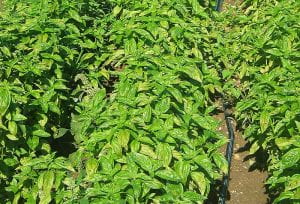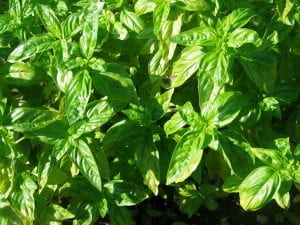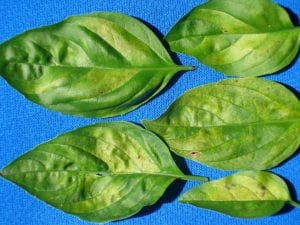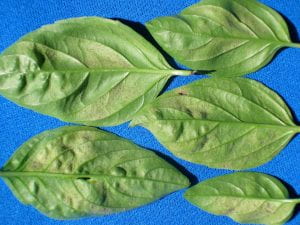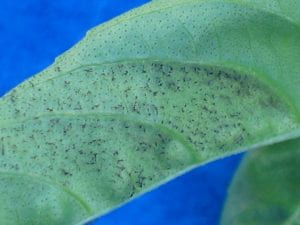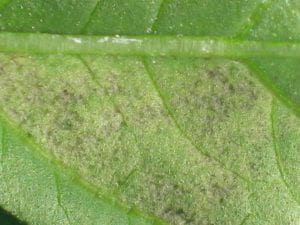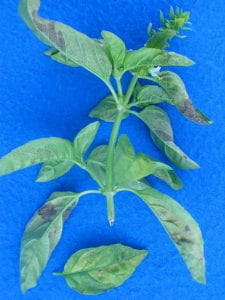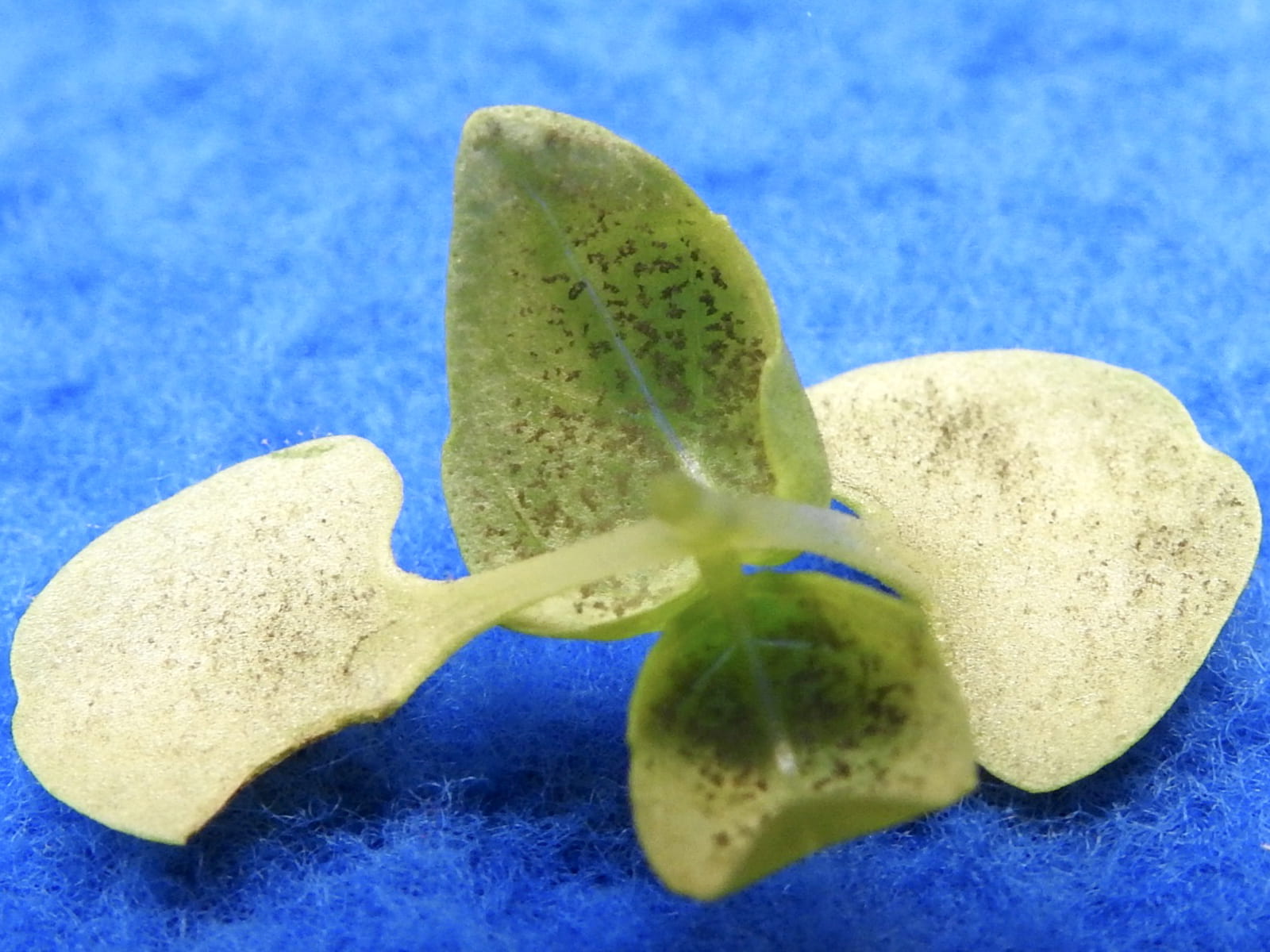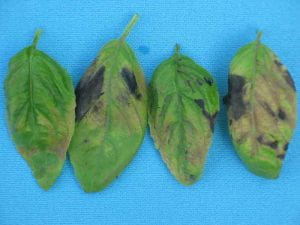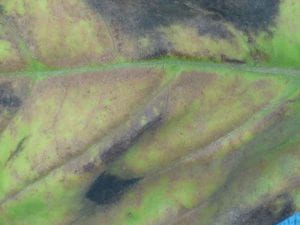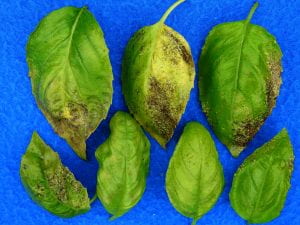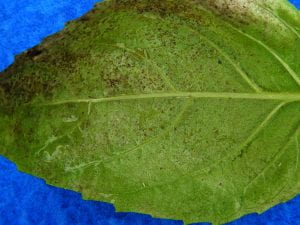Updated March 2023. (Originally prepared for Vegetable MD Online.)
Important update: New fungicide (Orondis Ultra) registered for field use in 2021. More information below.
Topics on this page:
- Symptoms and signs
- Other problems that could be confused for basil downy mildew
- Management of downy mildew in field-grown basil
Additional information:
- Management of downy mildew in greenhouse basil
- Additional photographs of basil downy mildew
- Microscopic Views of basil downy mildew
- Reporting occurrences for monitoring program
- Past occurrence information from monitoring program
- Occurrence on Long Island of Basil Downy Mildew Pathogen Race 1 that Overcomes some Resistant Varieties
- Results of research evaluating resistant varieties, biopesticides, and fungicides
- Extension and outreach webpage on basil downy mildew at LIHREC website
- Sweet basil cultivars resistant to downy mildew evaluated under open field conditions (article on research conducted at Cornell published in Crop Protection, 2024)
- Efficacy of organic fungicides for downy mildew in field-grown sweet basil (article on research conducted at Cornell published in Plant Disease, August 2023)
- Effective management using resistant varieties, environment modifications, and fungicides (review article in Plant Health Progress, Oct 2021)
- Efficacy of conventional fungicides for downy mildew in field-grown sweet basil in the US (article on research conducted at Cornell published in Plant Disease, 2020)
- Basil downy mildew (Peronospora belbahrii): Discoveries and challenges relative to its control (review article in Phytopathology, July 2015)
Downy mildew has been the most common and most important (damaging) disease of basil in the United States (US) since it was first reported in south Florida in October 2007. In 2008 it was confirmed in both field- and greenhouse-grown basil crops, as well as home gardens across the eastern US and Canada. Downy mildew is caused by the Oomycete Peronospora belbaharii. The pathogen’s abundantly produced spores can be readily wind-dispersed. This is the main dispersal mechanism enabling the pathogen to disperse throughout the eastern US every summer, similar to its well-known relative causing cucurbit downy mildew. P. belbaharii is also seed-borne. Leaves with any symptoms are rendered unmarketable especially for sale as fresh herb. Downy mildew has caused complete crop loss.
Symptoms and Signs
The first step in preparing for basil downy mildew is learning the symptoms (Fig. 1-6). The most noticeable symptom is chlorosis which can resemble a nutritional deficiency (Fig. 1, below), thus when downy mildew first occurred growers generally did not recognize the presence of a disease. Later, the downy-appearing sporulation of the pathogen develops almost exclusively on lower leaf surfaces (Fig. 4-5). Observing spores on the underside of leaves is key to diagnosis. Because spores are produced during the dark night period, early morning is the best time to inspect basil for downy mildew. Leaves with yellowing resembling downy mildew but lacking spores can be placed upside down on a wet paper towel in a closed plastic bag in dark for a day to induce spore production, if the pathogen is present. Visit the Downy Mildew on Basil photo gallery (LIHREC) for additional images.
Additional possible causes of leaf chlorosis and necrosis in basil should be considered when making a diagnosis. Physiological injuries and insect herbivory (Fig. 7-10) can cause similar symptoms, and it is important to distinguish the causal agents.
Fig. 1: Leaves of basil affected by downy mildew are yellow (chlorotic) with affected tissue eventually dying and becoming brown (necrotic).
Fig. 2: Yellowing of the upper surface of affected basil leaves often occurs in sections of the leaf delineated by veins because the downy mildew pathogen cannot grow past major veins in leaves.
Fig. 3: Purplish gray spores of the downy mildew pathogen only develop on the lower surface of leaves. These are the same leaves in Fig. 2. Sporulation coincides with yellowing on the opposite side of the leaf.
Fig. 4: Close-up views of sporulation in sections on the lower surface of leaves.
Fig. 5: Yellowing, necrosis, and sporulation on basil leaves and flower bracts.
Fig. 6: Basil is susceptible to downy mildew from emergence. Symptoms on both recently emerged first leaves plus both cotyledons of young seedlings may indicate the seedling is systemically infected due to the seed being contaminated with the pathogen, especially when there are no affected plants nearby to serve as a source of spores and there are many unaffected seedlings in the planting.
Other problems that could be confused for basil downy mildew
Fig. 7: Injury to basil leaves from sunburn or other physiological cause resembles downy mildew but lacks the angular appearance and characteristic sporulation on the lower surface.
Fig. 8: A close-up of damage demonstrates the lack of angular lesions and characteristic sporulation.
Fig. 9: Thrips frass and injury from a severe infestation could be mistaken for downy mildew due to its dark color. Note that it lacks the dusty, fuzzy appearance of downy mildew pathogen sporulation.
Fig. 10: A close-up of thrips damage demonstrates the lack of the fuzzy appearance of downy mildew sporulation. The tiny, yellow, rice-shaped objects on this leaf are thrips larvae.
Management
Using seed not infested with the basil downy mildew pathogen, selecting a less susceptible variety, and applying fungicides are the primary management practices for downy mildew. Pathogen-free seed is most important for plantings not expected to be exposed to wind-dispersed spores, such as greenhouse crops when too cold outdoors for basil to survive. Minimizing leaf wetness and reducing humidity to obtain conditions unfavorable for disease development may suppress downy mildew in greenhouses. An article focused on management in greenhouses is available. This pathogen is not known to be able to survive in the absence of living plants. The rest of this webpage has details about management.
Seed Tests
Recent efforts to develop a seed test have resulted in a genetic-based procedure specifically for Peronospora belbahrii that is now being validated (suspected contaminated seeds are needed for this step, see information about submitting samples below). And Eurofins STA Laboratories in Colorado now tests basil seed for Peronospora spp. It is sufficient to test only at the genus level with this pathogen since it is the only species of Peronospora that would be associated with basil seed.
Seed Treatment
Seed companies (including High Mowing Organic Seeds) are starting to steam treat basil seed. It is not amenable to hot-water treatment because while in water the seed produces a gelatinous exudate.
Varieties
Read what Meg McGrath had to say when interviewed by Johnny’s Selected Seeds: Monitoring, Reporting & Management: Margaret McGrath, PhD, School of Integrative Plant Science, Cornell
Good suppression of downy mildew can be obtained with new resistant varieties that started to be marketed in 2018. They are the fruition of several years of conventional breeding by breeders working separately on this goal. It can take many crosses to obtain a plant with resistance plus all the desired horticultural traits that are in a susceptible variety, which include for sweet basil large, smooth, dark green, downward cupped leaves with good classic sweet basil flavor.
Devotion, Obsession, Passion, and Thunderstruck are the first resistant varieties released from the Rutgers University basil breeding program. They are marketed by KBC Specialty Seeds and also distributed by several seed companies. Results from evaluations at Cornell (LIHREC) documented high level of resistance in these varieties and experimentals developed before them. Some symptoms did develop on these resistant varieties, which is typical because disease resistance is rarely immunity, but significantly less than on Eleonora. More symptoms were observed in 2020 and 2021 than previously, but suppression was still good. A few growers in the U.S. reported downy mildew being more severe on these varieties in 2021 than in the past. However, they all exhibited good resistance in the 2022 evaluation. Year-to-year variation in ability to suppress downy mildew may reflect how favorable conditions were for disease development. Fungicides are recommended applied to the Rutgers DMR varieties to achieve the high level of control needed for an herb that is marketed fresh.
Prospera is a series of varieties developed by Genesis Seeds Ltd. and being marketed by Johnny’s Selected Seeds and several other seed companies. They have a single duplicate dominant resistant gene (Pb1). No symptoms were found on plants in the evaluation conducted at Cornell in 2018. Very few symptoms were found in 2019, 2020, 2021, and 2022. In some evaluations conducted elsewhere there were some plants that became severely affected which was thought to be due to seed mix up. In Israel, where Prospera was developed, a new race (race 1) has been identified able to overcome the resistant gene in this variety. A few U.S. growers reported downy mildew being more severe on Prospera in 2021 and 2022 (including on Long Island, NY). Fortunately, a new resistant gene (Pb2) effective for the new race has been found. Experimental varieties with Pb1 and Pb2 were evaluated at LIHREC in 2021 and 2022.
- Prospera CG1 (Cut Genovese 1) – the original tall Genovese and the variety evaluated in 2018 – 2020 and listed as ‘Prospera’ in those evaluations.
- Prospera ILL2 (Italian Large-Leaf 2) – tall
- Prospera PL4 (Potted Large-Leaf 4) – compact with large leaf type
- Prospera PS5 (Potted Small-Leaf 5) – semi-compact with medium leaf size
- Prospera Red DMR – first red basil resistant to downy mildew
Amazel is a Proven Winners variety released from the University of Florida that also did not develop symptoms in the Cornell 2018 variety evaluation (LIHREC) and had very few symptoms in 2019 and 2020. It has the same source of resistance as the Prospera varieties. Its seed is sterile and thus sold as cuttings primarily for producing plants for the home garden market. It is being replaced by:
Pesto Besto is another Proven Winners variety from the University of Florida with the same source of genetic resistance as Amazel and the Prospera series. It can be grown from seed.
Organic seed is available of some of these varieties.
While above resistant varieties suppressed downy mildew very well in the Cornell evaluations, there have been a few reports of poor suppression elsewhere suggesting the pathogen has evolved to overcome resistance. Downy mildew appeared unsuppressed on Amazel plants in greenhouses on Long Island in spring 2019. Pathogen isolate from these plants was found to be genetically different from other US isolates examined. Please email mtm3@cornell.edu if you observe poor suppression of downy mildew on any resistant varieties listed above; a sample of your plants may be wanted to examine the pathogen.
Eleonora, the first commercially available resistant variety, demonstrates limited suppression.
Emma and Everleaf -aka Basil Pesto Party and M4828Z when evaluated at Cornell (LIHREC)- also have moderate resistance.
- Grower feedback on performance of downy mildew resistant varieties in terms of disease suppression, yield, flavor, appearance, marketability, etc. would be greatly appreciated. Please email mtm3@cornell.edu.
Research on resistance started with looking to see if there are inherent differences in susceptibility among varieties and species of basil, and to identify sources of genetic resistance. Commonly grown sweet basil (Ocimum basilicum) was shown to be more susceptible than some of the other exotic, spice, and ornamental basils such as O. citriodorum and O. americanum. All sweet basil varieties evaluated before breeding for resistance was started were found to be very susceptible. Other basil varieties with fewer symptoms in evaluations include red types (including ‘Red Leaf’ and ‘Red Rubin’), Thai basil (Queenette’), lemon basil (‘Lemon’, ‘Lemon Mrs. Burns’, ‘Sweet Dani Lemon Basil’), lime basil (‘Lime’), and spice types (‘Spice’, ‘Blue Spice’, ‘Blue Spice Fil’, ‘Cinnamon’). An article on this study is available as a PDF. Similar results were obtained in trials conducted in Illinois and Florida. Fewer symptoms were observed only on those basils that are different from sweet basil being distinct in visual appearance, aroma and flavor, and which have quite limited markets. The challenge in breeding for resistance to basil downy mildew is developing improved resistant varieties that still look, taste, grow and pack-out as a traditional high quality sweet basil.
In the future there may be resistant varieties that are the result of gene editing. Scientists have used CRISPR to knock out the gene that makes basil susceptible to the downy mildew pathogen. This type of resistance is functionally different from that in the conventionally bred resistant varieties and would be complementary incorporated in the same variety. An advantage of gene editing for creating a resistant variety compared to conventional breeding is the lack of need to conduct many rounds of back crossing to remove undesirable traits that come from the parent with the resistant gene(s) in the initial cross, such as undesirable aroma, flavor and small leaf size. An additional step needed to create Prospera was embryo rescue because it was an interspecies cross with a wild Ocimum resistant accession.
To achieve acceptable control, all resistant varieties need to be used with other management practices, in particular fungicides, due to very low tolerance for symptoms in herbs especially when marketed fresh. While a preventive application schedule is recommended with a susceptible variety, it may be possible to achieve effective control with a resistant variety by routinely scouting for symptoms and initiating a fungicide program as soon as symptoms are seen.
Fungicides
To control downy mildew effectively with fungicides, it is considered necessary to start before first symptoms and to make applications frequently. Many of the fungicides currently labeled for this new disease, plus others not registered yet, have provided limited suppression in some fungicide evaluations, demonstrating the difficulty in controlling this disease, especially in a research setting with applications made with a backpack sprayer, and thus the importance of starting before disease onset. Part of the challenge of controlling downy mildew is the need for blemish-free herbs when marketed as fresh sprigs.
To determine when to initiate a fungicide program and when to consider harvesting early to avoid losses to downy mildew, growers should not only sign up to receive alerts and routinely check the map of reported occurrences to determine when downy mildew is occurring on basil nearby, but also regularly inspect their crop for symptoms. The cucurbit downy mildew forecasting web site might be useful for predicting when conditions are favorable for basil downy mildew since both pathogens likely have similar requirements for successful wind dispersal long distances (e.g. overcast skies) and subsequent infection (e.g. wet leaves or high humidity). Summer is not a time to forget about this disease: unlike most other downy mildew pathogens, e.g. the ones affecting lettuce and cruciferous crops, which stop developing in summer, the basil downy mildew pathogen seems to develop best under moderate to warm temperatures while also tolerating cool temperatures. Don’t forget to report occurrence of downy mildew as soon as possible at the monitoring page or via e-mail to mtm3@cornell.edu.
Organic Fungicides
Badge X2 (active ingredients are copper oxychloride and copper hydroxide), Cueva (copper octanoate), Procidic (citric acid) and Stargus (Bacillus amyloliquefaciens) are specifically labeled for basil downy mildew. Procidic is exempt from EPA registration under FIFRA and thus does not need to be registered in NY. There is a 2(ee) recommendation allowing use of the new botanical fungicide EcoSwing (extract of Swinglea glutinosa) for downy mildew in field-grown basil. Actinovate AG (Streptomyces lydicus), Double Nickel 55 (Bacillus amyloliquefaciens), MilStop (potassium bicarbonate), OxiDate (hydrogen dioxide), Regalia (extract of Reynoutria sachalinensis), TerraNeem EC (cold pressed neem oil), Trilogy (neem oil), and Zonix (rhamnolipid biosurfactant) are labeled for use on herbs and for suppressing foliar diseases including downy mildew. MilStop, OxiDate, Regalia, and Stargus are labeled for use outdoors and in greenhouses. The Actinovate, Cueva, Double Nickel, Procidic, TerraNeem, Trilogy, and Zonix labels do not have a statement prohibiting use in greenhouses. Double Nickel label has directions for greenhouse use for soil-borne pathogens. OxiDate has limited residual activity and thus if used should be combined with or followed by another product. All of these fungicides are OMRI-listed except for Procidic, which was reviewed and determined to be NOP compliant by Washington State Dept of Ag. Evaluations of most of these products conducted at Cornell (LIHREC) document the challenge of controlling downy mildew organically.
Conventional Fungicides for Field-Grown Basil
Orondis Ultra (oxathiapiprolin and mandipropamid; FRAC codes 49 and 40), Revus (mandipropamid; FRAC 40), Ranman (cyazofamid; FRAC 21), Presidio (fluopicolide; FRAC 43), Reason (fenamidone; FRAC 11), Quadris (azoxystrobin; FRAC 11), and phosphorous acid fungicides (FRAC P 07) can be used in conventional production of basil, in addition to the organic fungicides listed above. Reason is the only one not permitted used on Long Island. There are several phosphorous acid (phosphanate) fungicides labeled for this disease with no use restrictions, including ProPhyt, Fosphite, Fungi-Phite, Rampart, pHorsepHite, and K-Phite. These are recommended used in a tank mix with the other fungicides listed above. The others have use restrictions that need to be considered when developing a fungicide program. An important reason for these restrictions is to delay resistance development in the pathogen. Also note that Orondis Ultra and Revus share an active ingredient which affects their use in a program. Orondis Ultra can be applied in no more than a third of the applications (when there are at least 3 applications made to a crop for downy mildew), no more than 4 times total, with no more than 2 consecutive applications. Revus can be applied 4 times with no more than 2 consecutive applications, but not if Orondis Ultra is also applied because of the maximum amount of mandipropamid that can be applied to a basil crop (0.52 lb/A), which is the amount in 4 applications of Orondis Ultra when applied at its highest label rate. Ranman can be applied 9 times with no more than 3 consecutive applications which must be followed by the same number of applications of other fungicides. Presidio can be applied 3 times. Resistance management restrictions for Presidio require it be tank mixed with another fungicide labeled for this disease that has a different mode of action; rotation with other chemistry is recommended in the general resistance management section of its label. Reason can be applied 4 times with no consecutive applications of it or another FRAC code 11 fungicide (e.g. Quadris). Quadris can be applied 6-15 times depending on rate with no more than 2 consecutive applications for resistance management. Quadris is labeled for use on basil but not specifically for downy mildew; it also has been shown to be effective for this downy mildew. In states like NY where the target disease is required to be specified on the label, Quadris cannot be used without an approved FIFRA 2(ee) recommendation, which the applicator must possess.
Example fungicide programs (based on label restrictions not efficacy results) which could start with any product in the list:
- Orondis Ultra or Revus; Orondis Ultra or Revus; Ranman; Ranman (apply up to 2 times; 8 applications total))
- Orondis Ultra or Revus; Ranman; Presidio + FRAC P 07 (apply up to 3 times; 9 applications total)
- Ranman; Ranman; Orondis Ultra or Revus; Presidio + FRAC P 07 (apply up to 3 times; 12 applications total)
- Orondis Ultra or Revus; Ranman; Ranman; Ranman; Orondis Ultra or Revus; Presidio + Reason or Quadris (apply up to 2 times; 12 applications total)
- Orondis Ultra or Revus; Ranman; Ranman; Ranman; Orondis Ultra or Revus; Presidio + Reason or Quadris (apply up to 2 times; 12 applications total)
- Orondis Ultra or Revus; Ranman; Ranman; Ranman; Reason or Quadris; Presidio + FRAC P 07 (apply up to 3 times; 18 applications total)
Reason or Quadris could be substituted for some of these fungicide(s) in programs that do not already include them.FRAC P 07 (phosphorous acid fungicide) could also be applied with the other fungicides in the program.
Orondis Ultra, Quadris and Presidio are not permitted to be used in a greenhouse.
These fungicides with targeted activity are prone to resistance development due to their single site mode of action and thus need to be used within a fungicide resistance management program. Resistance to mefenoxam (Ridomil) developed quickly in Israel demonstrating the capacity of this pathogen to develop resistance.
Ranman, Revus, and Reason were registered as a result of assistance from the IR-4 program. Ranman was the first product labeled with targeted activity for oomycetes, the group of pathogens that includes those causing downy mildews.
Results from research conducted at Cornell (LIHREC) documenting efficacy are available.
Conventional Fungicides for Greenhouse Basil
Ranman, Revus and phosphorous acid fungicides are permitted to be used in a greenhouse. See previous paragraph for use information and resistance concerns. Heritage SC (azoxystrobin; FRAC 11), Micora (mandipropamid; FRAC 40), Segovis (oxathiapiprolin; FRAC 50, previously U15), and Subdue MAXX (mefenoxam; FRAC 4) are additional fungicides that can be used in greenhouse-grown plants for retail sale to consumers. It is important to use a fungicide resistance management program including alternation among as many chemistries based on FRAC code as possible. Heritage can be applied once to plants at each production stage, plug and finish. It must be applied in alternation with another fungicide. Micora and Segovis also can be applied at most twice to a crop. Micora can only be used in an enclosed greenhouse with permanent floor. Segovis can also be used in outdoor nurseries. Subdue MAXX can be applied once to foliage and must be tank-mixed with another fungicide labeled for this use and applied at full label rate. Phosphorous acid fungicides can be tank-mixed with any of these greenhouse fungicides. Micora, Segovis, and Subdue MAXX can only be applied to foliage of plants for retail sale as transplants; they are not permitted used on plants to be marketed as fresh herbs in grocery stores.
Please Note: The specific directions on fungicide labels must be adhered to — they supersede these recommendations if there is a conflict. Any reference to commercial products, trade or brand names is for information only; no endorsement is intended.
Other Practices
Practices that minimize leaf wetness and reduce humidity may contribute to control. These include planting where there is full sunlight and good air movement with rows parallel to the prevailing wind direction, maximizing plant spacing, and using drip irrigation. However, these practices will not suppress dew formation or high humidity over night creating very favorable conditions for infection and spore formation. Gardeners can avoid by bringing potted plants indoors (LIHREC). Humidity can be lowered in greenhouses by using circulating fans and lights, by increasing temperature, and with dehumidification. Humidity needs to be below 85% within the plant canopy to suppress downy mildew. Observations of downy mildew occurrence in field and greenhouse basil plantings suggest that environmental conditions can significantly affect severity of downy mildew.
Fanning is a practice developed and being used in Israel for basil grown in protected culture. It entails directing greenhouse fans toward plants so that leaves move. This prevents water depositing on leaves when humidity is high.
Illuminating either leaf surface of plants growing under protected conditions during nighttime was shown to effectively suppress downy mildew by inhibiting spore production through a study conducted in Israel. Light was supplied in high tunnel-like structures with 20W Day Light fluorescent bulbs each equipped with a white metal reflector (30 cm diameter), with one bulb per meter row. Spores formed on leaf tissue shaded by other leaves, thus this procedure is most effective when plants are small. Initial experiments were done with illumination throughout night. Recent research has revealed light exposure is most important during the first 6 hours of night. Red light was shown to be the most inhibitory under laboratory conditions. Downy mildew also developed slower on basil under red light in a greenhouse experiment conducted at the University of Florida.
High temperature is lethal to the pathogen. Maximum temperatures for infection, colonization, and spore production are 80 – 88 F. Research conducted in growth chambers demonstrated that temperatures up to 113 F kill spores and mycelium of the pathogen in affected plants, with length of effective exposure decreasing with higher temperature range, least being 6 – 9 hours at 104 – 113 F. Subsequently solar heating has been used to cure plants in Israel by closing greenhouse vents or using a transparent IR polyethylene sheet covering during sunny days. It is recommended done at first sign of downy mildew and over 3 consecutive days with 3 – 4 hours exposure. It necessitates routine monitoring to ensure temperature reaches effective range while not rising high enough to kill plants. If temperature does not go about 95 F, treating for a fourth day is recommended.
Basil crops should be disked under or otherwise destroyed as soon as possible after last harvest, or when abandoned because of disease, to eliminate this source of inoculum for other plantings. A sunny day is the best time to physically destroy an affected crop because the disturbed spores will be killed by UV radiation.
Cultural, sanitation practices are not needed after basil plants with downy mildew are destroyed. Downy mildews are caused by obligate pathogens which means they can only survive after their host plant dies if they are able to produce oospores. The spores (sporangia) formed in the pathogen’s fuzzy growth on leaves (sporangiophores) that are not dispersed in air currents from this growth to healthy basil leaves, only survive for a few days, longer if they are in a dark, damp area. These sporangia are dependent on chance movement by wind from where they land to healthy leaf tissue. The thick-walled oospores, which are capable of remaining dormant for a long time, form when two pathogen individuals of opposite mating type (pathogen equivalent of gender) grow together and sexually reproduce. This is not known to occur with the basil downy mildew pathogen.
More information/prepared by:
Margaret Tuttle McGrath
Associate Professor
Long Island Horticultural Research and Extension Center (LIHREC)
Plant Pathology and Plant-Microbe Biology Section
School of Integrative Plant Science
College of Agriculture and Life Sciences
Cornell University
mtm3@cornell.edu



